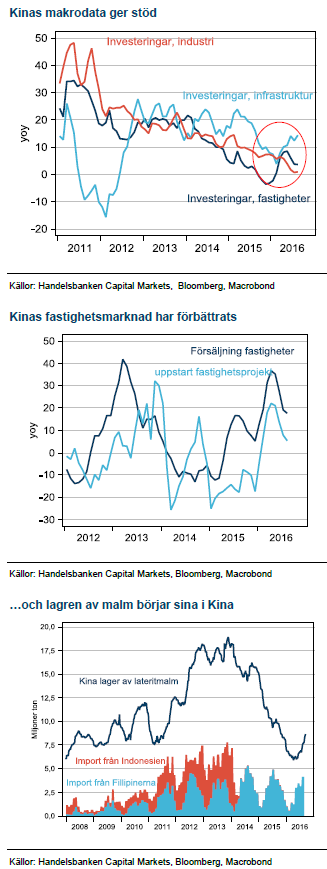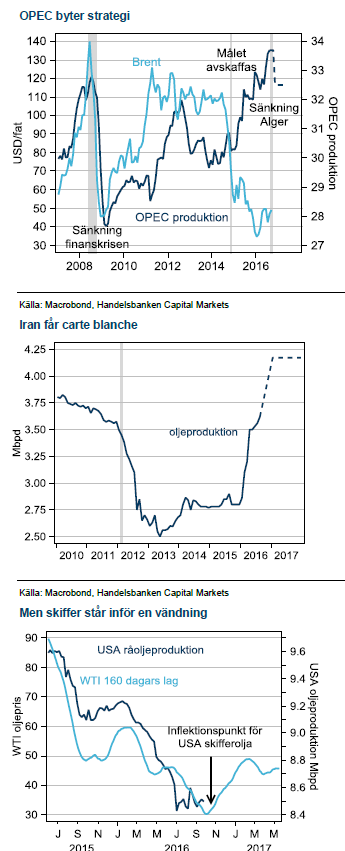Analys
Råvaruplanket: Med stöd från Kina och OPEC

Inte sedan brinnande finanskris 2008 har OPEC enats om att sänka produktionen av råolja. Överraskningen efter beslutet att byta två års medvetet låga priser till ett försöka att minska produktionen vid det extra mötet i Alger i slutet av september var total.
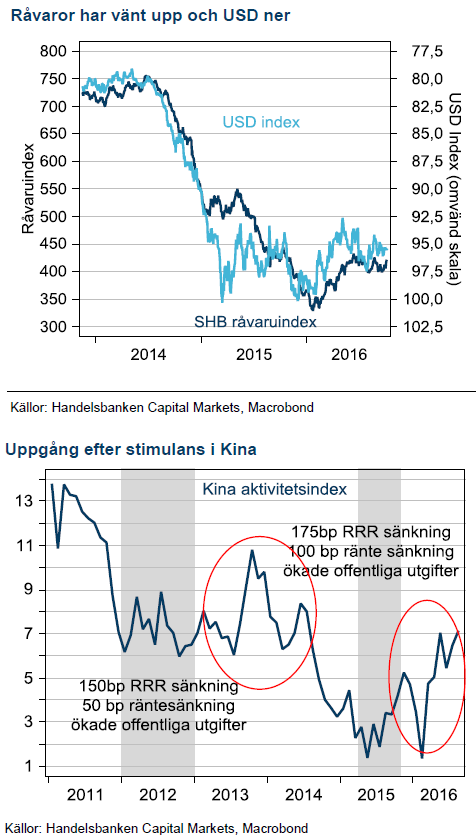 Något höll på att hända givet Saudiarabiens förändrade retorik inför mötet. Landet har hamnat allt mer i kläm efter två års budgetunderskott. Maktkampen med Iran har spelat ut i Irans favör och Saudiarabien valde till slut att göra en kovändning. Nu ska mycket bevisas, historiskt har alltid implementering varit svårare än beslut för OPEC, men vi tror diskussionerna räcker för att ge oljan stöd med omkring USD 10 och höjer vår tro från USD 40 till USD 50 vid slutet av året.
Något höll på att hända givet Saudiarabiens förändrade retorik inför mötet. Landet har hamnat allt mer i kläm efter två års budgetunderskott. Maktkampen med Iran har spelat ut i Irans favör och Saudiarabien valde till slut att göra en kovändning. Nu ska mycket bevisas, historiskt har alltid implementering varit svårare än beslut för OPEC, men vi tror diskussionerna räcker för att ge oljan stöd med omkring USD 10 och höjer vår tro från USD 40 till USD 50 vid slutet av året.
Kinas ”minicykel” börjar bli en ”mediumcykel”
Basmetallerna som grupp har nu stigit tre kvartal på raken. Det har inte hänt sedan återhämtningen efter finanskrisen i slutet av 2010 till början av 2011. Kinas återhämtning det här året kommer från riktade stimulanser mot fastighetsmarknaden och infrastruktur under 2015. En gammal väl beprövad metod som konsumerar mycket industriella metaller. Vi trodde tidigare att cykeln skulle börja mattas i slutet av året men data fortsätter komma in på bra nivåer och vi tror därför på fortsatt stigande priser för basmetaller.
Slår Fed till i december?
Senaste vågen av bankrelaterad finansiell tumult i Europa med Deutsche Bank i centrum har inte väckt investerares behov av säker hamn i guld på samma sätt som tidigare. Sedan ett kraftigt kliv upp efter Brexit-valet har guld hamnat under svag press. Vi tror att marknadens förväntningar om en höjning från Fed i december skapar en tillfällig ovilja till guld. Efter en höjning ser vi nya möjligheter för guld och silver men utgångsläget är sämre i år då endast en räntehöjning är annonserad för 2017.
Vår syn för Q4 16 och Q1 2017:
Basmetaller
För första gången på två år har tunga industriråvaror som basmetaller, järnmalm och stål fått draghjälp från efterfrågesidan i prisekvationen. Kinas investeringsvåg i infrastruktur och fastigheter har triggat efterfrågan som får marknaden att minnas ”supercykeln”. I längden är den dock inte hållbar då den underliggande tillväxten trendar nedåt och det är staten som står bakom investeringarna. Frågan är hur länge vågen varar?
Räntor var första indikatorn på att politiken höll på att svänga till ultrastimulativ. Tillsammans med lägre krav på bostadsköpare fick det fart på försäljningen av fastigheter och så småning om också byggandet. Därefter kom statliga investeringar i infrastruktur. Dessa efterfrågar industriråvaror på bred front.
Vissa indikatorer tyder på att stimulanserna är på väg att rulla ut. Fastighetsdata är bästa exemplet på det. Politikerna vill inte ha för stora prisuppgångar och har därför åter börjat kyla ner den delen av ekonomin. Infrastruktur och inte minst senaste inköpschefsindex tyder på att aktiviteten kommer att bestå ytterligare en tid. Vi förlänger därför vår tro på positiva stimulanseffekter även under Q1.
Zink och nickel står starkt
Vår tro på högre zink och nickelpriser har besannats, och av rätt skäl. Brist i marknadsbalansen efter stängda gruvor för zink, då flera stora är utbrutna och för nickel, efter miljöutvärderingen på Filippinerna. Störst effekt i marknaden räknar vi med först under 2017 när höga lagernivåer betats av. Vi fortsätter därför att tro på stigande priser trots uppgångar på knappa 50% för zink och 20% för nickel det här året.
Stigande kopparproduktion hämmar
De divergerande förutsättningarna för basmetaller på utbudssidan spelar fortfarande in, trots Kinas starkare efterfrågan under året. Koppar handlas i princip oförändrad i år, trots Kinaeffekterna. Högre produktion från nya gruvor är förklaringen. Vi sätter därför en speciell varningsflagga för koppar på nedsidan när Kinas stimulanser rullar ut ur systemet.
Aluminium har stigit i bakvattnet av högre produktionskostnad när kol- och oljepriserna gått upp. Marknadsbalansen är dock välförsörjd.
Energi
OPEC:s informella möte i Alger slutade med en skräll när man meddelade att man var överrens om att skära ner på produktionen. Saudiarabien har varit prisnedgångens största påivrare av en fri marknaden som ska rebalansera sig själv när högkostnadsproducenter tvingas lägga ner produktionen. Strategin har visat sig fungera dåligt, högkostnadsproducenterna sänker sina produktionskostnader i takt med att priset faller och marknaden står idag, två år senare, kvar med ett stort överskott långt in i 2017.
Press från alla håll
Saudiarabien är det land som har svårast att skära ner på utgifterna. Rädslan för Arabiska vårens uppror är påtaglig och att finansiera budgetunderskottet med högre skuldsättning kommer att bli allt svårare när utsikterna för oljepriset att återhämta sig falnar. Landet sitter fast i ett högt oljeberoende och prins Mohammed Bin Salmans ambitiösa planer på att diversifiera ekonomin, bland annat genom att sälja delar av det statliga oljebolaget, Aramco har kommit i skymundan av prinsens problem med kriget mot Iran i Jemen. Det finns ingen strategi för Saudi att komma ur Jemen. Prinsen är även försvarsminister och hans stjärna har därför dalat.
Det bästa beviset på Saudiernas desperation är att de låter Iran undantas från avtalet. Iran kan fortsätta att öka sin produktion och samtidigt åtnjuta ett högre pris från övrigas neddragningar. Även Nigeria och Libyen ska exkluderas efter rådande utbudsstörningar enligt avsiktsförklaringen.
Mycket kvar till nytt jämviktspris
Nu ska OPEC först komma överrens om landskvoter. Därefter ska Ryssland förhandla om att delta. Vi tror att dessa diskussioner fram till nästa möte 30/11 i Wien kommer att ge stöd till oljepriset.
För 2017 är det mycket som ska bevisas. Historiskt har OPEC haft mycket svårt att solidariskt dela på minskad produktion. Den här gången lär dessutom Saudi vara extremt krävande. Samtidigt hotar ökad aktivitet i skifferindustrin. Därifrån ser vi ny press på oljan under kommande sex månader.
Ädelmetaller
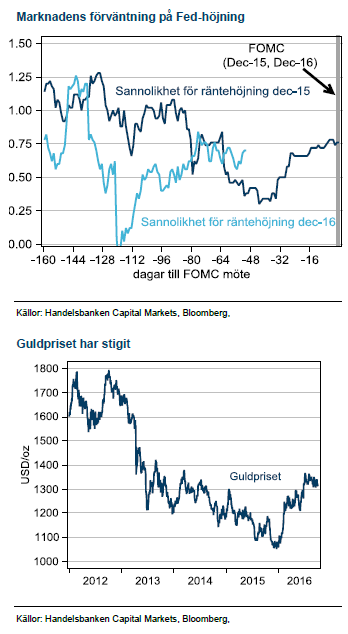 Feds huvudvärk är guldets gnista
Feds huvudvärk är guldets gnista
Efter en initial press på guld, sedan Fed startat sin räntehöjningscykel i december 2015, så fick guldet massor av drivkraft från att Fed och marknaden reviderade ner antalet räntehöjningar. Nu återstår bara en chans, vid decembermötet, om man antar att de vill ha en presskonferens i anslutning till mötet för att prata om sin höjning.
Vi tror att det blir en höjning i december. Det gör marknaden också som just nu prissätter omkring 60% sannolikhet för en höjning. Det gör sannolikt guld och silver något mindre attraktiva inför decembermötet, och förklarar guldets svaga utveckling de senaste veckorna, trots drivkraft från ökat tumult i Europa.
Ingen repris nästa år
För 2017 ser vi inte en enkel repris av 2016. För ett år sedan trodde marknaden på fler höjningar under 2016 och det signalerade även Fed. Det kom ju sedan på skam och guldet glänste. Den här gången har Fed bara en höjning under 2017 och marknaden har bara 80% sannolikhet för en höjning fram till slutet av 2017. Det betyder att det inte finns mycket utrymme för att revidera ner förväntansbilden på antalet höjningar från Fed.
Brexit bakom oss och framför oss
Storbritanniens önskan om att lämna EU blev en gnista för guld som säker hamn. Riskerna för spridning till andra länder, med kommande val i flera EU-länder, är den största risken i dag som skulle kunna trigga ett ökat intresse för guld. Storbritanniens del av Brexit ligger sannolikt bakom oss för guldets del. Nu väntar segdragna förhandlingar och guldet brukar snarare reagera på oväntade chocker än eventuellt försämrade utsikter för BNP tillväxt.
Jordbruk
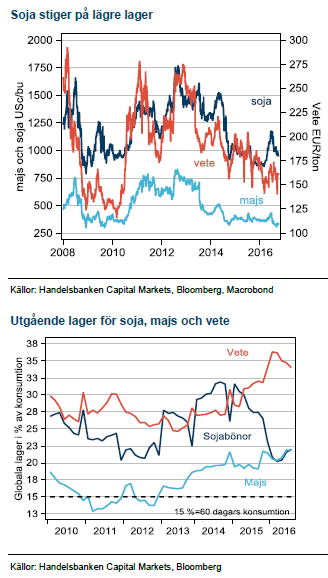 Sedvanlig skördeeffekt för vetepriserna
Sedvanlig skördeeffekt för vetepriserna
Vete i Paris har fallit tillbaka ned mot årets lägsta nivåer efter en uppgång i början av juli. Regn och översvämningar med efterföljande kvalitetsproblem i Europa och Ryssland låg bakom mycket av den tidigare uppgången.
När skörden runt om i världen nu i det närmaste är klar har den sedvanliga riskpremien fallit ur priserna. Veteskörden globalt blev volymmässigt bra och lokalt sämre skörd i Europa kompenseras av större skördar runt Svarta havet, USA och Australien. Globala vetelager går mot fjärde året i rad med stigande nivåer vilket pressat priserna, samt delvis skapat en buffert för eventuella problem framöver. Bland de stora exportörerna, med stor påverkan på världsmarknadspriset, är det främst USA vars lager nått väldigt höga nivåer – detta som följd av inte minst en stärkt dollar med försvårade exportmöjligheter. Lager hos flera övriga stora exportörer, däribland EU och Kanada har dock minskat och globala lager exklusive Kina (vilka för vete ej är så aktiva på export/ import) är faktiskt ned något från föregående säsong.
Om nästa års skörd ökar på nuvarande lager finns det fortfarande viss nedsida i vetepriser, låga priser är alltså ingen garanti för att undvika ännu lägre priser. Vi är dock i tron om att vetepriser nått eller åtminstone är väldigt nära en botten nu. Det är alltså främst i USA som lagernivån är riktigt hög och med rådande låga priser väntas de amerikanska lantbrukarna även i år minska vetearealen till förmån för andra grödor. Det begränsar möjligheten för fortsatt lageruppbyggnad i USA vilket i kombination med mer måttliga lager för flera övriga exportländer och kvalitetsproblem bör ge ett stöd åt vetepriser framgent.
Soja och majs
Majs- och sojaskörden i USA pågår för fullt, i söndags var majsskörden till 24 procent klar och sojaskörden till 26 procent klar – marginellt efter det normala. Avkastningsnivån är hög, förväntningar finns dock att USDA kommer få justera ned prognosen för majsen något, vilket ger visst stöd åt majspriset som handlas kring historiskt sett låga nivåer. Det råder ingen brist i världen på vare sig majs eller soja.
[box]SHB Råvarukommentar är producerat av Handelsbanken och publiceras i samarbete och med tillstånd på Råvarumarknaden.se[/box]
Ansvarsbegränsning
Detta material är producerat av Svenska Handelsbanken AB (publ) i fortsättningen kallad Handelsbanken. De som arbetar med innehållet är inte analytiker och materialet är inte oberoende investeringsanalys. Innehållet är uteslutande avsett för kunder i Sverige. Syftet är att ge en allmän information till Handelsbankens kunder och utgör inte ett personligt investeringsråd eller en personlig rekommendation. Informationen ska inte ensamt utgöra underlag för investeringsbeslut. Kunder bör inhämta råd från sina rådgivare och basera sina investeringsbeslut utifrån egen erfarenhet.
Informationen i materialet kan ändras och också avvika från de åsikter som uttrycks i oberoende investeringsanalyser från Handelsbanken. Informationen grundar sig på allmänt tillgänglig information och är hämtad från källor som bedöms som tillförlitliga, men riktigheten kan inte garanteras och informationen kan vara ofullständig eller nedkortad. Ingen del av förslaget får reproduceras eller distribueras till någon annan person utan att Handelsbanken dessförinnan lämnat sitt skriftliga medgivande. Handelsbanken ansvarar inte för att materialet används på ett sätt som strider mot förbudet mot vidarebefordran eller offentliggörs i strid med bankens regler.
Analys
Tightening fundamentals – bullish inventories from DOE

The latest weekly report from the US DOE showed a substantial drawdown across key petroleum categories, adding more upside potential to the fundamental picture.

Commercial crude inventories (excl. SPR) fell by 5.8 million barrels, bringing total inventories down to 415.1 million barrels. Now sitting 11% below the five-year seasonal norm and placed in the lowest 2015-2022 range (see picture below).
Product inventories also tightened further last week. Gasoline inventories declined by 2.1 million barrels, with reductions seen in both finished gasoline and blending components. Current gasoline levels are about 3% below the five-year average for this time of year.
Among products, the most notable move came in diesel, where inventories dropped by almost 4.1 million barrels, deepening the deficit to around 20% below seasonal norms – continuing to underscore the persistent supply tightness in diesel markets.
The only area of inventory growth was in propane/propylene, which posted a significant 5.1-million-barrel build and now stands 9% above the five-year average.
Total commercial petroleum inventories (crude plus refined products) declined by 4.2 million barrels on the week, reinforcing the overall tightening of US crude and products.


Analys
Bombs to ”ceasefire” in hours – Brent below $70

A classic case of “buy the rumor, sell the news” played out in oil markets, as Brent crude has dropped sharply – down nearly USD 10 per barrel since yesterday evening – following Iran’s retaliatory strike on a U.S. air base in Qatar. The immediate reaction was: “That was it?” The strike followed a carefully calibrated, non-escalatory playbook, avoiding direct threats to energy infrastructure or disruption of shipping through the Strait of Hormuz – thus calming worst-case fears.

After Monday morning’s sharp spike to USD 81.4 per barrel, triggered by the U.S. bombing of Iranian nuclear facilities, oil prices drifted sideways in anticipation of a potential Iranian response. That response came with advance warning and caused limited physical damage. Early this morning, both the U.S. President and Iranian state media announced a ceasefire, effectively placing a lid on the immediate conflict risk – at least for now.
As a result, Brent crude has now fallen by a total of USD 12 from Monday’s peak, currently trading around USD 69 per barrel.
Looking beyond geopolitics, the market will now shift its focus to the upcoming OPEC+ meeting in early July. Saudi Arabia’s decision to increase output earlier this year – despite falling prices – has drawn renewed attention considering recent developments. Some suggest this was a response to U.S. pressure to offset potential Iranian supply losses.
However, consensus is that the move was driven more by internal OPEC+ dynamics. After years of curbing production to support prices, Riyadh had grown frustrated with quota-busting by several members (notably Kazakhstan). With Saudi Arabia cutting up to 2 million barrels per day – roughly 2% of global supply – returns were diminishing, and the risk of losing market share was rising. The production increase is widely seen as an effort to reassert leadership and restore discipline within the group.
That said, the FT recently stated that, the Saudis remain wary of past missteps. In 2018, Riyadh ramped up output at Trump’s request ahead of Iran sanctions, only to see prices collapse when the U.S. granted broad waivers – triggering oversupply. Officials have reportedly made it clear they don’t intend to repeat that mistake.
The recent visit by President Trump to Saudi Arabia, which included agreements on AI, defense, and nuclear cooperation, suggests a broader strategic alignment. This has fueled speculation about a quiet “pump-for-politics” deal behind recent production moves.
Looking ahead, oil prices have now retraced the entire rally sparked by the June 13 Israel–Iran escalation. This retreat provides more political and policy space for both the U.S. and Saudi Arabia. Specifically, it makes it easier for Riyadh to scale back its three recent production hikes of 411,000 barrels each, potentially returning to more moderate increases of 137,000 barrels for August and September.
In short: with no major loss of Iranian supply to the market, OPEC+ – led by Saudi Arabia – no longer needs to compensate for a disruption that hasn’t materialized, especially not to please the U.S. at the cost of its own market strategy. As the Saudis themselves have signaled, they are unlikely to repeat previous mistakes.
Conclusion: With Brent now in the high USD 60s, buying oil looks fundamentally justified. The geopolitical premium has deflated, but tensions between Israel and Iran remain unresolved – and the risk of missteps and renewed escalation still lingers. In fact, even this morning, reports have emerged of renewed missile fire despite the declared “truce.” The path forward may be calmer – but it is far from stable.
Analys
A muted price reaction. Market looks relaxed, but it is still on edge waiting for what Iran will do

Brent crossed the 80-line this morning but quickly fell back assigning limited probability for Iran choosing to close the Strait of Hormuz. Brent traded in a range of USD 70.56 – 79.04/b last week as the market fluctuated between ”Iran wants a deal” and ”US is about to attack Iran”. At the end of the week though, Donald Trump managed to convince markets (and probably also Iran) that he would make a decision within two weeks. I.e. no imminent attack. Previously when when he has talked about ”making a decision within two weeks” he has often ended up doing nothing in the end. The oil market relaxed as a result and the week ended at USD 77.01/b which is just USD 6/b above the year to date average of USD 71/b.

Brent jumped to USD 81.4/b this morning, the highest since mid-January, but then quickly fell back to a current price of USD 78.2/b which is only up 1.5% versus the close on Friday. As such the market is pricing a fairly low probability that Iran will actually close the Strait of Hormuz. Probably because it will hurt Iranian oil exports as well as the global oil market.
It was however all smoke and mirrors. Deception. The US attacked Iran on Saturday. The attack involved 125 warplanes, submarines and surface warships and 14 bunker buster bombs were dropped on Iranian nuclear sites including Fordow, Natanz and Isfahan. In response the Iranian Parliament voted in support of closing the Strait of Hormuz where some 17 mb of crude and products is transported to the global market every day plus significant volumes of LNG. This is however merely an advise to the Supreme leader Ayatollah Ali Khamenei and the Supreme National Security Council which sits with the final and actual decision.
No supply of oil is lost yet. It is about the risk of Iran closing the Strait of Hormuz or not. So far not a single drop of oil supply has been lost to the global market. The price at the moment is all about the assessed risk of loss of supply. Will Iran choose to choke of the Strait of Hormuz or not? That is the big question. It would be painful for US consumers, for Donald Trump’s voter base, for the global economy but also for Iran and its population which relies on oil exports and income from selling oil out of that Strait as well. As such it is not a no-brainer choice for Iran to close the Strait for oil exports. And looking at the il price this morning it is clear that the oil market doesn’t assign a very high probability of it happening. It is however probably well within the capability of Iran to close the Strait off with rockets, mines, air-drones and possibly sea-drones. Just look at how Ukraine has been able to control and damage the Russian Black Sea fleet.
What to do about the highly enriched uranium which has gone missing? While the US and Israel can celebrate their destruction of Iranian nuclear facilities they are also scratching their heads over what to do with the lost Iranian nuclear material. Iran had 408 kg of highly enriched uranium (IAEA). Almost weapons grade. Enough for some 10 nuclear warheads. It seems to have been transported out of Fordow before the attack this weekend.
The market is still on edge. USD 80-something/b seems sensible while we wait. The oil market reaction to this weekend’s events is very muted so far. The market is still on edge awaiting what Iran will do. Because Iran will do something. But what and when? An oil price of 80-something seems like a sensible level until something do happen.
-

 Nyheter4 veckor sedan
Nyheter4 veckor sedanStor uppsida i Lappland Guldprospekterings aktie enligt analys
-

 Nyheter4 veckor sedan
Nyheter4 veckor sedanSilverpriset släpar efter guldets utveckling, har mer uppsida
-

 Nyheter3 veckor sedan
Nyheter3 veckor sedanUppgången i oljepriset planade ut under helgen
-

 Nyheter3 veckor sedan
Nyheter3 veckor sedanLåga elpriser i sommar – men mellersta Sverige får en ökning
-

 Nyheter2 veckor sedan
Nyheter2 veckor sedanMahvie Minerals växlar spår – satsar fullt ut på guld
-

 Analys3 veckor sedan
Analys3 veckor sedanVery relaxed at USD 75/b. Risk barometer will likely fluctuate to higher levels with Brent into the 80ies or higher coming 2-3 weeks
-

 Nyheter1 vecka sedan
Nyheter1 vecka sedanOljan, guldet och marknadens oroande tystnad
-

 Nyheter1 vecka sedan
Nyheter1 vecka sedanJonas Lindvall är tillbaka med ett nytt oljebolag, Perthro, som ska börsnoteras



